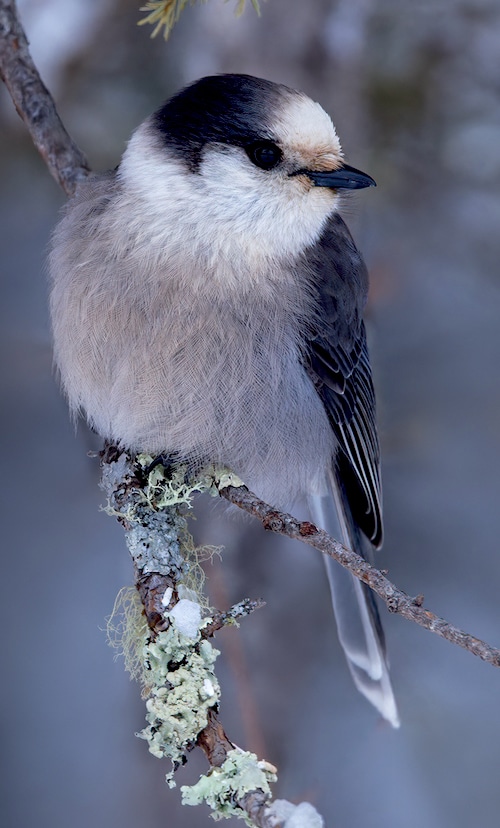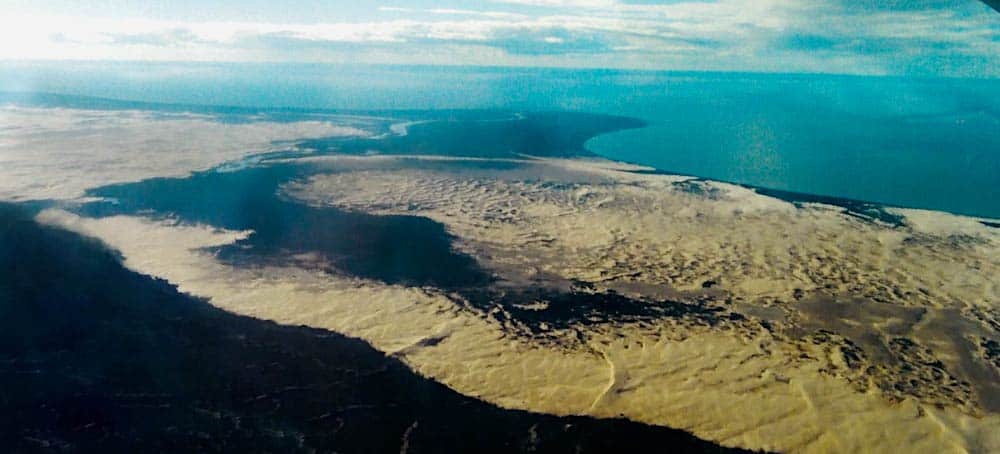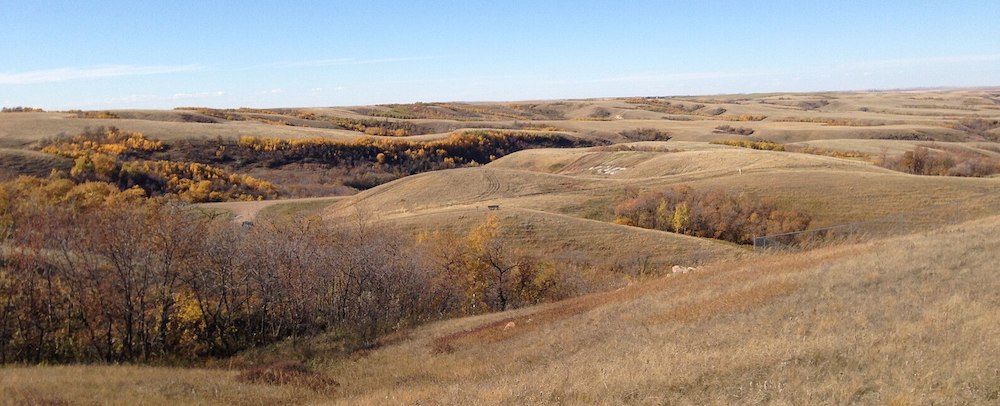Saskatchewan

Saskatchewan is a province in Western Canada, bordered on the west by Alberta, on the north by the Northwest Territories, on the east by Manitoba, to the northeast by Nunavut, and to the south by the United States (Montana & North Dakota). Saskatchewan and Alberta are the only landlocked provinces of Canada. Saskatchewan’s total area is over 650,000 km2 (c.250,000 square miles), of which, c.10% is fresh water, mostly rivers, reservoirs, and lakes.
Saskatchewan contains two major natural regions: the boreal forest in the north and the prairies in the south. They are separated by an aspen parkland transition zone near the North Saskatchewan River on the western side of the province, and near to south of the Saskatchewan River on the eastern side. Northern Saskatchewan is mostly covered by forest except for the Lake Athabasca Sand Dunes, the largest active sand dunes in the world north of 58°, and adjacent to the southern shore of Lake Athabasca. Southern Saskatchewan contains another area with sand dunes known as the “Great Sand Hills” covering over 300 km2 (120 sq mi). The Cypress Hills, in the southwestern corner of Saskatchewan and Killdeer Badlands (Grasslands National Park), are areas of the province that were unglaciated during the last glaciation period, the Wisconsin glaciation. The province has 14 major drainage basins made up of various rivers and watersheds draining into the Arctic Ocean, Hudson Bay and the Gulf of Mexico.

Lake Athabasca Sand Dunes – ©Tim Beckett, CC BY 2.0 via Wikimedia Commons
Saskatchewan’s population is around 1,225,000 people primarily live in the southern prairie half of the province, while the northern half is mostly forested and sparsely populated. Roughly half live in the province’s largest city Saskatoon (approaching 280,000 people) or the provincial capital Regina (nearly 250,000 people). Other notable cities include Prince Albert, Moose Jaw, Yorkton, Swift Current, North Battleford, Estevan, Weyburn, Melfort, and the border city Lloydminster.
Saskatchewan receives more hours of sunshine than any other Canadian province. The province lies far from any significant body of water. This fact, combined with its northerly latitude, gives it a warm summer, corresponding to its humid continental climate in the central and most of the eastern parts of the province, as well as the Cypress Hills; drying off to a semi-arid steppe climate in the southwest. Drought can affect agricultural areas during long periods with little or no precipitation at all. The northern parts of Saskatchewan from about La Ronge northward, have a subarctic climate with a shorter summer season. Summers can get very hot, sometimes above 38 °C during the day, and with humidity decreasing from northeast to southwest. Warm southern winds blow from the plains and intermontane regions of the Western United States during much of July and August, very cool or hot but changeable air masses often occur during spring and in September. Winters are usually bitterly cold, with frequent Arctic air descending from the north, with temperatures not breaking −17 °C for weeks at a time. Warm chinook winds often blow from the west, bringing periods of mild weather. Annual precipitation averages 30 to 45 centimetres (12 to 18 inches) across the province, with the bulk of rain falling in June, July, and August.
Saskatchewan is one of the most tornado-active parts of Canada, averaging roughly 12 to 18 tornadoes per year, some violent. In 2012, 33 tornadoes were reported in the province. Severe and non-severe thunderstorm events also occur, usually from early spring to late summer. Hail, strong winds and isolated tornadoes are a common occurrence.
Birding Saskatchewan
Often simply described as a prairie province of the Canadian interior, Saskatchewan tends to escape much of the attention that its rich diversity should attract. Birders, however, recognise this province as a key breeding area and migration resting area, offering to its over 400 recorded bird species a variety of habitats, including forests, bogs, freshwater and saline lakes, grasslands, and sloughs.

Saskatchewan Praire – Public Doimain via Wikimedia Commons

Northern Saskatchewan Forest – ©purecanucks CC BY 2.0 via Wikimedia Commons
Birders will discover an ever-changing landscape as they travel around the province. Deglaciation, with its erosive and depository processes, sculpted Saskatchewan’s landscape and created distinct differences in soil and vegetation. Elevations range from 213 metres at Lake Athabasca to 1,392 metres at Cypress Hills. As a result, within its trapezoidal borders, Saskatchewan houses four major ecosystems that correspond to the northern sub-arctic region, the Canadian Shield, the southern boreal forest, and the prairie.
These broad ecosystems can be further divided into smaller eco-regions and again into even smaller important landscape areas, each with its own particular mix of plant, mammal and bird species. Sub-arctic woodland, Precambrian rocks, peatland and numerous lakes characterize the Taiga Shield. The Boreal Shield is noted for its bedrock outcrops, sand dunes, eskers, wetlands and lakes. The Boreal Plain boasts steep escarpments, glacial till plains and wetlands. Finally, the Prairie, which covers only 38% of the province, contains aspen groves, glacial till and glacial lake plains, sand hills, potholes and badlands.
Even though more than half of the province has a sub-arctic climate, the rest being continental and steppe climates, with temperatures ranging from -40 degrees Celsius in the winter to +40 degrees in the summer, Saskatchewan is the home or resting place for large numbers of many bird species. It is the summer home for one quarter of the world’s population of American White Pelicans and it is an important breeding area for the Bald Eagle, American Avocet, Forster’s Tern, Gadwall, Ruddy Duck, and Northern Pintail, to name a few.
In recent history, humans have been carving the landscape of Saskatchewan, with agricultural development and forestry altering ecosystems and thereby affecting the species that live there. Officially, the populations of 15 species of birds in Saskatchewan are currently at risk. The Greater Prairie Chicken has been extirpated. Endangered species include Whooping Crane, Sage Thrasher, Piping Plover, Mountain Plover, and Burrowing Owl. The Sage Grouse and Loggerhead Shrike populations are also threatened. Vulnerable species include the Ferruginous Hawk, Peregrine Falcon, Long-billed Curlew, Short-eared Owl, Caspian Tern, and Red-headed Woodpecker.
To fully appreciate a birding experience in Saskatchewan, visiting birders need to understand its various ecosystems and the current status of bird species in this vast province. Among the growing number of birding websites offering such information, the Birding in Canada website is a valuable resource on birding in Saskatchewan, including information on birding hotspots.
(NB Some information drawn from Atlas of Saskatchewan: University of Saskatchewan, 1999)
-
Number of bird species: 436
Provincial Bird - Sharp-tailed Grouse Tympanuchus phasianellus
-
Avibase
PDF ChecklistSaskatchewan -
Nature Saskatchewan
PDF ChecklistThis checklist includes 436 species of birds recorded in Saskatchewan. The 393 species in the main body have been confirmed by a specimen, photograph or sound recording. Another 43 hypothetical species, lacking similar evidence, are listed separately. -
Wikipedia
Annotated ListThis list of birds of Saskatchewan includes all the bird species confirmed in the Canadian province of Saskatchewan as determined by Nature Saskatchewan. As of September 2017, there were 436 species on the Nature Saskatchewan checklist
-
Birds of Saskatchewan
| Edited by Alan R Smith, C Stuart Houston & J Frank Roy | Nature Saskatchewan | 2019 | Hardback | 768 pages, colour photos, colour illustrations, colour distribution maps | ISBN: 9780921104346 Buy this book from NHBS.com -
Quick Reference to Manitoba & Saskatchewan Birds
| Lone Pine Publishing | 2013 | Paperback | 12 pages, colour illustrations | ISBN: 9781551058955 Buy this book from NHBS.com -
Saskatchewan Birds
| By Alan Smith | Lone Pine Publishing | 2001 | Paperback | 176 pages, Colour illustrations, maps | ISBN: 9781551053042 Buy this book from NHBS.com
-
Last Mountain Bird Observatory
Observatory WebsiteSatellite ViewThe station is open for spring migration (May 8-31) and for fall migration (August 8 - October 7). Please email Jordan Rustad, bander in charge to book your visit to LMBO.
-
Royal Saskatchewan Museum - Ornithology
Ornithology CollectionThe Ornithology collection consists of 9,900 skins, mounts, skeletons, and tissue samples. 87% of the specimens are from Saskatchewan. -
University of Saskatchewan
CourseIntroduction to the diversity of birds of the world. Lecture material focuses on evolution, ecology, behaviour, physiology and conservation. Laboratories focus on morphological diversity and taxonomy.
-
Local Societies & Affiliates
WebpageLocal Natural History societies were instrumental in establishing Nature Saskatchewan ( Sask. Natural History Society) back in 1949. With this long standing and historically based relationship local societies form a vital role in the natural heritage community in the province. -
Nature Regina
WebsiteNature Regina’s Mission is to foster a greater appreciation of all aspects of the natural environment through presentations, field trips, education programs and environmental advocacy. -
Nature Saskatchewan
WebsiteNature Saskatchewan is one of the largest conservation organizations in the province. We are striving to help protect Saskatchewan's native species and natural ecosystems - our biological wealth. Nature Saskatchewan believes that a healthy natural environment and sustainable economy is crucial for the survival and well-being of present and future generations… -
Sask Birders
Facebook PageThis is a place for people with a love of birding to share their photographs, insights and experiences with other like minded people. -
Saskatoon Nature Society
Facebook PageThe Saskatoon Nature Society brings together those interested in the natural world. Our objective is to promote the appreciation of nature and encourage a deeper knowledge of it through observation and sharing of experience. Our society supports nature conservation projects and is an active advocate for the preservation of plant and animal habitats.
-
Chaplin Lake
InformationSatellite ViewChaplin Lake was designated a Western Hemispheric Shorebird Reserve Network site in May of 1997. This is the highest designation possible. There are only 35 sites in the Western Hemisphere with only 5 of them being in Canada and only 2 of these are Hemispheric… -
IBA Quill Lakes
InformationSatellite ViewThis new website highlights the Quill Lakes International Bird Area in Saskatchewan, Canada. This birding hotspot hosts millions of birds annually with one day counts exceeding 250,000. Large concentrations of ducks, geese, cranes, and shorebirds. The site has numerous international designations including an Important Birding Area. The area includes Canada's largest saline lake and Canada's largest breeding population of endangered piping plovers. Facilities include the Quill Lakes Interpretive Centre, the Wadena Wetlands Viewing Area, and the Foam Lake Heritage Marsh Viewing Area. -
IPP Cypress Hills
WebsiteSatellite ViewWhere in Saskatchewan can you find lush green forests of lodgepole pine and white spruce towering over colourful and unique meadows of wild flowers, high plateaus and surrounded by natural prairie grasslands? The Cypress Hills… -
NWA Bradwell
InformationSatellite ViewBradwell National Wildlife Area (NWA) is located in the mixed-grass prairie ecodistrict of central Saskatchewan. Wetlands consist of five inter-connected permanent basins which receive run-off water from the surrounding undulating land. A system of dykes, ditches and water control structures maintain water levels in the basins and help to supply water to several adjacent marshes via the main Saskatoon southeast supply canal. Native grassland surrounds most of the wetlands. Native grasses, tame grasses and legumes seeded on previously cultivated land provide dense nesting cover for waterfowl. Woodland is comprised of small scattered aspen-willow bluffs. A Ducks Unlimited (Canada) cairn on the Wildlife Area acknowledges donors who funded the project… -
National Parks
WebpageSatellite ViewSaskatchewan boasts two national parks: Prince Albert National Park in the northern boreal forest, and Grasslands National Park in the rolling hills of the southwest. The two national parks are perfect examples of the province’s varied landscape. -
Saskatchewan Provincial Parks
WebsiteSatellite ViewEach park or site provides an opportunity to experience a different part of Saskatchewan’s heritage, including the solitude of a northern forest, the comforts of a modern resort, or the experience of walking in the steps of those who came before us.
-
Saskatchewan Birding
ForumWelcome to Saskatchewan Birding, a group for discussions pertaining to the natural history of wild birds
-
Avocet Tours
Tour OperatorMassive numbers of migrating Sandhill Cranes expected, along with one of the world’s rarest living birds, the Whooping Crane as they move south to wintering grounds. We saw a whopping 157 Whooping Cranes in one day on our 2018 tour!! -
Eagle-Eye Tours
Tour OperatorIn the fall, Sandhill Cranes migrate by the thousands south across southern Saskatchewan, stopping at various localities to refuel before continuing their journey. With them are a handful of Whooping Cranes, coming south from breeding grounds in Wood Buffalo National Park in the Northwest Territories. -
Living Sky
Tour OperatorSee both eastern and western North American birds during the peak of the breeding season. -
Meadowlark Birding Tours
Tour OperatorIn late spring, the prairie regions of Saskatchewan and Alberta the landscape is filled with birds. The wetlands hold a variety of breeding waterfowl and shorebirds while the grasslands are teaming with sparrows and longspurs. -
Saskatoon Custom Bird Tours
Tour OperatorWe offer private and group guided bird watching tours out of Saskatoon, Saskatchewan, Canada. Some of our special tours include viewing dancing grouse (spring), prairie birds (summer), Whooping Cranes (fall), Snowy Owls (winter). Custom tours and zoom-based bird ID workshops available.
-
2019 [06 June] - Derek - Saskatchewan Grasslands
ReportThis was a self-guided tour with 12 very specific targets. We used ebird to locate the targets and we got all but one! I have only mentioned our targets birds in the following trip report. Having said that it was a great route and we certainly saw a number of other things along the way. I should mention for anyone hiring a car that we could not find a car rental company that would rent to us in Canada and allow us to leave the car in Denver which is why we started out flying to Great Falls, Montana. -
2021 [10 October] - Avocet Tours
ReportWe turned off the paved highway onto a dusty dirt road, and in the distance we could see some large white birds standing in a field. They were Whooping Cranes. There were 27 of them there, all together in a flock. Twenty-six were adults and just one was a rusty juvenile... -
2022 [06 June] - Stan Shadick - Cypress Hills...
ReportWe made our first stop at a prairie slough SW of Saskatoon, Saskatchewan which had a rich variety of waterfowl and other water birds. Our 38 species here included Canada Geese, 11 duck species, Pied-billed, Horned and Eared Grebes, Sora, our first Upland Sandpiper, 3 Marbled Godwit, 3 Black-billed Magpies, 1 Marsh Wren our first Vesper and Savannah Sparrows plus 10 Yellow-headed Blackbirds and 2 singing Western Meadowlarks. -
2023 [09 September] -
ReportI managed to get back to Saskatoon to visit my parents for the first time in 5 years. It was not a birding trip but I snuck out a couple times to some local sites.
-
Crane Spotting
WebsiteSaskatchewan, the staging area for the 4,000-kms (2,500-mile) migration, one of the best places in the world to observe the elegant cranes. The environment is stable, the birds are widely dispersed throughout it, and it`s accessible while thinly populated. Whooping cranes can linger more than a month here while foraging for the grain that fuels their long trip -
Living Sky Wildlife Rehabilitation
WebsiteOur Mission: To provide a safe place for injured and orphaned wild animals to grow and mend until they can return to their natural habitat while encouraging public tolerance and understanding of wildlife. -
Saskatchewan Chimney Swift Initiative
WebpageIn Canada, Chimney Swifts are listed as Threatened (COSEWIC; 2007). As with many species of insectivores, populations of Chimney Swifts have declined significantly in recent years. Habitat loss and the reduction of sufficient quality/quantity of insect prey are thought to be major contributing factors. It is essential to understand the distribution and abundance of Chimney Swifts, and their biology, in order to implement conservation measures to halt or reverse the population decline. -
Saskbirds
WebsiteBIRDS OF SASKATCHEWAN IN PICTURES - Once we set foot outside the door of our home, we enter the world of wildlife where birds are the most noticeable residents. The numerous species of birds and their varied songs soon make them a focus of our attention. For many, bird watching (birding) becomes a therapeutic outlet, something that was especially evident when COVID restrictions limited our travels to more local opportunities.

